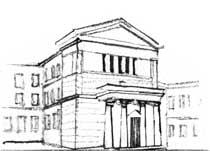"Theory of Duality" (KMMF) Seminar
2006/2007 | 2007/2008 | 2008/2009 | 2009/2010 | 2010/2011 | 2011/2012 | 2012/2013 | 2013/2014 | 2014/2015 | 2015/2016 | 2016/2017 | 2017/2018 | 2018/2019 | 2019/2020 | 2020/2021 | 2021/2022 | 2022/2023 | 2023/2024 | 2024/2025 | Seminar homepage
2011-06-02 (Thursday)
Javier de Lucas Araujo (IM PAN)
Układy Liego--Hamiltona: teoria i zastosowania
Układy Liego to rodzina układów równań różniczkowych zwyczajnychpierwszego rzędu, których ogólne rozwiązania mogą by zapisaneza pomocą funkcji, tzw. zasady superpozycji, pewnych skończonychrodzin rozwiązań układu i zbioru stałych.W czasie tego wykładu opiszę podstawowe właściwości układówLiego i pokażę kilka nowych zastosowań tych układów w fizyce i matematyce.Dokładniej, pokażę, że układy Liego mogą byc wykorzystywanedo badań równań Kummera-Schwarza, oscylatorów Winternitza_Smorodinsky'ego i równań różniczkowych Riccatiego drugiego i trzeciegorzędu.W związku z tym, przedstawię nowy rodzaj układów Liego na rozmaitości Poissona, tzw. układy Liego-Hamiltona, które posiadają wieleinteresujących właściwości geometrycznych. Te właściwości mogą bycużywane do badań symetrii Liego, zasady superpozycji i innych cechtakich układów Liego.
2011-05-26 (Thursday)
Christian Gerard (U Paris Sud)
Scattering theory for the Klein-Gordon equation with non-positive energy
2011-05-19 (Thursday)
Marcin Napiórkowski (KMMF)
Interpolacja - od analizy harmonicznej do PDE
2011-05-12 (Thursday)
Zygmunt Lalak (KMMF)
Supersymetria i zapach BSM
Rozpoczął się okres doświadczalnego testowania teorii opisujących naruszeniesymetrii elektrosłabej i rozszerzających Model Standardowy oddziaływańfundamentalnych w kierunku wielkich energii. Opowiem o wiodącej teoriiwykraczającej poza SM i rozwiązującej "wielki" problem hierarchii tzn osupersymetrii, oraz o perspektywach uzyskania informacji eksperymentalnych pozwalających wyjść poza problem hierarchii.
2011-04-28 (Thursday)
Tomasz Radożycki (KMMF)
Ścisły rachunek perturbacyjny w modelu Schwingera
2011-04-14 (Thursday)
Paweł Nurowski (IFT)
Planowanie misji kosmicznych w układzie słonecznym
2011-03-31 (Thursday)
Paweł Kasprzak (KMMF)
Teoria reprezentacji zwartych grup Liego, twierdzenie Borela-Weila
2011-03-24 (Thursday)
Katarzyna Grabowska (KMMF)
Algebroidy i struktury Diraca
2011-03-17 (Thursday)
Maciej Łukasik (KMMF)
Rachunek wariacyjny bez parametryzacji
2011-03-10 (Thursday)
Paul F. Baum (Penn State U, IMPAN)
Atiyah-Singer revisited
This is an expository talk about the Atiyah-Singer indextheorem. First, some low dimensional examples of the theorem will beconsidered. Next, a special case of the index theorem willbe proved as a corollary of Bott periodicity. Finally, the proof willbe outlined that the special case implies the full theorem. This is anexpository talk intended for non-specialists.
2011-03-03 (Thursday)
Klasyka - przejście fazowe w klasycznym, trójwymiarowym modelu Heisenberga (KMMF)
Jacek Wojtkiewicz
2011-02-24 (Thursday)
Krzysztof Byczuk (IFT)
Teoria dynamicznego pola średniego dla skorelowanych bozonów na sieciach
Omówiona zostanie konstrukcja dynamicznego pola średniego dlaoddziałujących bozonów na sieci. Teoria ta opisuje bozony normalne i wkondensacie na sieciach optycznych. Jest tez ścisłym rozwiązaniembozonowego Hamiltonianu Hubbarda w granicy nieskończonej liczbykoordynacyjnej. Zostana również przedstawione motywacje do podjęcia tegotematu i wstępne wyniki numeryczne.
2011-02-17 (Thursday)
Paweł Urbański (KMMF)
Samosprzężone rozszerzenia a redukcje symplektyczne
2011-01-20 (Thursday)
Kazimierz Napiórkowski (KMMF)
Dlaczego funkcje pierwotne pewnych funkcji elementarnych nie są funkcjami elementarnymi?
Będzie mowa o pracach Liouville'a na ten temat, według książeczki J.F.Ritta"Integration in finite parts".
2011-01-13 (Thursday)
Adam Skalski (IM PAN)
O klasycznej i kwantowej entropii dynamicznej
Miarowa i topologiczna entropia dynamiczna są liczbowyminiezmiennikami odgrywającymi podstawową rolę przy badaniu klasycznychukładów dynamicznych. Przypomnimy ich definicje i związki między nimi.Następnie opowiemy o analogicznych pojęciach dla kwantowych układówdynamicznych, rozumianych jako endomorfizmy C*-algebr, skupiając sięna definicji nieprzemiennej entropii topologicznej zaproponowanejprzez Voiculescu. Na przykładzie 'kwantowego' przesunięcia na algebrzeCuntza omówimy pewne naturalne zależności między entropią klasyczną ikwantową. Pokażemy też, że w ogólności relacje między tymi pojęciamimogą być dość skomplikowane.
2010-12-09 (Thursday)
Joanna Jaszuńska (CSZ PW)
Paradoksalny rozkład kuli
2010-12-02 (Thursday)
Adam Rennie (Australian National University)
A little index theory
I begin by describing the various classical index theorems andtheir unified proof(s) by Atiyah and Singer. Then I will show how theabstract framework of one of these proofs led to noncommutative geometry,in the sense of Alain Connes.The story comes full circle when the local index formula in noncommutative geometryis employed to give new proofs of the Atiyah-Singer theorem, and provide nontrivialgeneralisations.
2010-11-25 (Thursday)
Rafał Suszek (KMMF)
Strings, gerbes, and all that. 1. Generalities (cd)
2010-11-18 (Thursday)
Rafał Suszek (KMMF)
Strings, gerbes, and all that. 1. Generalities
It has, by now, been rather well understood that the proper language inwhich to give a lagrangean formulation of the two-dimensional non-linearsigma model, regarded as a classical description of the critical bosonicstring (and of relevance in the study of certain condensed-matter systems,as well as models of statistical physics), is that of the theory ofgerbes. These latter are higher-cohomological structures with adifferential-geometric realisation whose rôle in string theory isanalogous to that played by fibre bundles in the modelling of the dynamicsof a charged pointlike particle moving in an external electromagneticfield. The talk, to be regarded as a fairly general overview of the stateof art in this field of mathematical physics in two dimensions, aspires tooutline some basic aspects of gerbe theory relevant to the classical andquantum description of poly-phase string world-sheets and string-theorydualities, laying due emphasis on the higher-categorial structure thatunderlies the theory of gerbes.In the first part of the talk, conceived as an elementary introduction tothe applications of the theory of gerbes and associated structures in thecontext of two-dimensional field theory (and to be further expatiated uponat the seminar ``Methods of Geometry in Physics'' of 24 XI 2010), thesource of gerbe-theoretic structures in the lagrangean approach shall beindicated, their naturality shall be discussed and certain significantconsequences of their existence shall be enumerated. Thus, in particular,the action functional of the sigma model with a generic configurationbundle shall be re-derived, the concept of transgression, whichcanonicallyassociates to the gerbe structure a pre-quantum bundle of the model, shallbe presented, the notion of a conformal defect, intimately related to thatof a string-theory duality, shall be introduced, and, finally, the gaugeprinciple for groupoidal symmetries of the string, illustrating the ideaof categorial descent, shall be formulated. Time permitting, we shallembellish the general discourse with a handful of explicit workingconstructions.
2010-11-04 (Thursday)
Wlodzimierz M. Tulczyjew (KMMF)
A variational principle for field theory
2010-10-28 (Thursday)
Yuliya Kuznetsova (U Luxembourg)
Nonmeasurable products and continuity of group representations
It is known that there exist discontinuous weakly measurable unitary representationsof locally compact groups. We show that if one uses a bit stronger variant ofmeasurability, every measurable unitary representation turns out to be continuous.Another close result depends on the axioms of set theory: under Continuum hypothesis(or certain weaker assumptions) every measurable homomorphism from a locally compactgroup into any topological group is continuous. This relies, in turn, on thefollowing theorem (proved under the same assumptions): for every zero measure set Sin a locally compact group there is a set A such that AS is non-measurable.
2010-10-21 (Thursday)
Marek Cieplak (IF PAN)
Od ekspresji genów do sieci genetycznych
2010-10-14 (Thursday)
Joseph C. Varilly (University of Costa Rica)
Natural Wigner orbitals for two-electron systems
2010-10-07 (Thursday)
Ryszard Rudnicki (Uniwersytet Ślaski)
Chaos dla nieskończenie wymiarowych układów dynamicznych
W pierwszej części wykładu przedstawimy powiązania między różnymi definicjami chaosu. Spróbujemy wyjaśnić różnicę między chaosem dla układów skończenie i nieskończenie wymiarowych i czy chaos w istocie występuje tylko w układach nieliniowych. W szczególności zwrócimy uwagę na podejście stochastyczne do chaosu wykorzystujące aparat miar niezmienniczych [1]. W przypadku, gdy układ dynamiczny działa na przestrzeni nieskończenie wymiarowej, a tak jest w przypadku układów dynamicznych generowanych za pomocą równań cząstkowych, miary niezmiennicze będą otrzymywane z miar wienerowskich. Następnie zaprezentujemy model układu krwiotwórczego działającego w szpiku kostnym, w którym występują jednocześnie procesy dojrzewania i podziału komórek prowadzące od komórek niezróżnicowanych do dojrzałych komórek wprowadzanych do krwioobiegu. W modelu tym interesują nas gęstości rozkładu dojrzałości komórek. Otrzymujemy układ dynamiczny działający na gęstościach na odcinku [0,1], a więc w podzbiorze przestrzeni L^1[0,1]. Okazuje się, że układ ten jest chaotyczny, a dowód chaosu oparty jest na zastosowaniu metody miar niezmienniczych [2]. Zaprezentowany przykład jest o tyle zaskakujący, że do tej pory nie znaliśmy chaotycznego układu dynamicznego działaj±cego na gęstościach.[1] R. Rudnicki, Chaos for some infinite-dimensional dynamical systems, Math. Meth. Appl. Sci. 27 (2004), 723-738.[2] R. Rudnicki, Chaoticity of the blood cell production system, Chaos: An Interdisciplinary Journal of Nonlinear Science, 19 (2009), 043112, 1--6.







